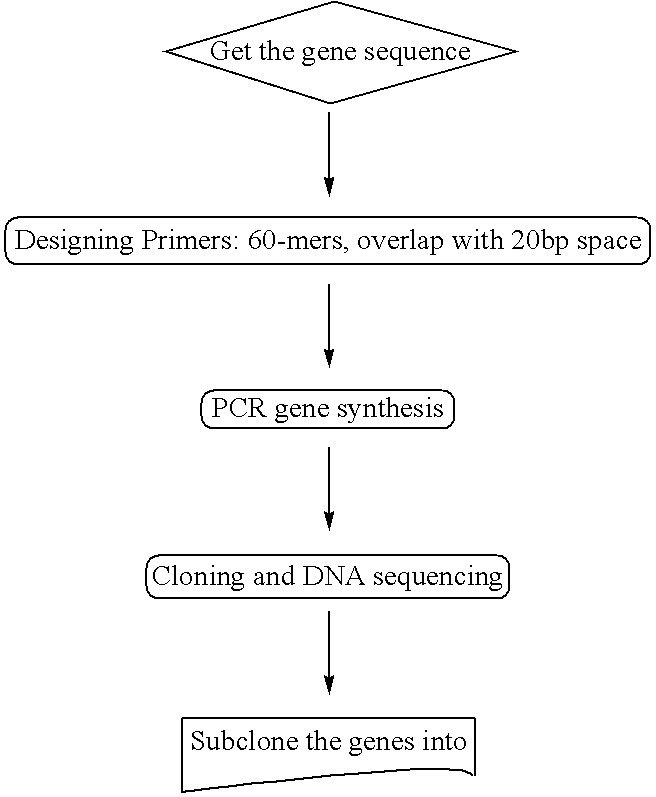Process for producing poly-unsaturated fatty acids by oleaginous yeasts
a technology of oleaginous yeast and polyunsaturated fatty acids, which is applied in the field of process for producing polyunsaturated fatty acids by oleaginous yeast, can solve the problems of inability and failure to achieve single or multiple enzymes to convert the carbon source into the end produ
- Summary
- Abstract
- Description
- Claims
- Application Information
AI Technical Summary
Benefits of technology
Problems solved by technology
Method used
Image
Examples
example 1
Cloning of D6-desaturase
[0036] The oleaginous yeast Y. lipolyitca was found to produce LA but not fatty acids downstream of the pathway shown in FIG. 1, such as GLA. The oleaginous yeast Y. lipolyitca is found in lack of D6-desaturase, which is the critical enzyme responsible for converting linoleic acid (LA) to GLA. Therefore we sought to generate transgenic Y. lipolyitca that produces GLA by introducing expression construct containing D6-desaturase cDNA sequence into Y. lipolyitca.
[0037] The cloning procedure was as follows:
Gene synthesis of M. alpina Delta 6 and Delta 12 desaturases
[0038] 1. The cDNA sequence of M. alpina D6-desaturase was found in the GenBank database. The cDNA sequence of D6-desaturase is shown in FIG. 2. [0039] 2. Primer design: 60-mer as an unit, 20 bp as non-overlapped space between 2 units. [0040] 3. Mix all primers together, and perform the first PCR reaction. Using the first PCR product as template, perform the second PCR reaction as directed by th...
example 2
[0042] Constructing Expression Vector pINA1311-D6 and pINA1311-D12
TABLE 2primers for vector construction.PrimernameSequenceNoteD6F5′- AATGGCTGCTGCTCCCAGTGTG -3′Delta-6forwardprimerD6R5′- TTACTGCGCCTTACCCATCTTG -3′Delta-6reverseprimerD12F5′- AATGGCACCTCCCAACACTATC -3′Delta-12forwardprimerD12F5′- TTACTTCTTGAAAAAGACCAC -3′Delta-12reverseprimer[0043] 1. pINA1311 -D6 vector construction
[0044] pINA1311 vector (a gift from LGMC, INRA-CNRS, CBAI, INA P-G, Thiverval Grignon, France, a vector system described in FEMS Yeast research 2: 371-379) digested with the restriction enzyme PmlI, in the 100 μl reaction buffer: 1X NE Buffer I, 1 mM MgCl2, 20 μg pINC1311, 20U PmlI, 2U shrimp alkaline phosphatase (SAP), 37° C., 16 hr, using Gel extraction kits (Viogene) for recovering pINA1311.
[0045] Delta-6 desaturase gene was PCR amplified with D6F and D6R as primers, in the 50 μl reaction buffer: 20 mM Tris-HCl (pH 8.8 at 25° C.), 10 mM (NH4)2SO4, 10 mM KCl, 0.1% Triton X-100, 0.1 mg / ml BSA, 20 mM M...
example 3
Transformation of Y. lipolytica Using Expression Vector pINA1311-D6 and pINA1311-D12
[0053]Y. lipolytica Transformation
Materials and methodsYNBD + CG plate (1 L)One-step Transformation bufferYeast nitrogen basePEG 50%(w / o a.a and A.S.)1.7 g2 M LiOAcAmmonium sulfate 5 g2 M DTTcasamino acid 1 gsodium glutamate 1 gSSDNA (10˜12K)glucose 2%agarose 2%a.a.
Transformation Protocol [0054] 1. Pick up several yeast (Polf) colonies. Dissolve in 1 ml ddH2O, vortex for seconds. [0055] 2. Check the cell density under microscope. Adjust the cell density to 1˜5×107 / ml. [0056] 3. Plate each YPD plate with 100 μl aliquot (1˜5×106 / plate). Incubate at 28° for 20˜24 hours. [0057] 4. Digest the pINA1311D6 and pINA1311D12 with Not I R.E. Final concentration is 0.2 μg / μl. [0058] 5. Scrape cells from plate with tooth pick. Dissolve cells in 1 ml ddH2O. Calculate the cell density.
[0059] 6. Spin down about 5×107 cells( 3000 g, 5 min.). Discard the supernatant. Mix with the buffer:
PEG 50%90uLLiOAc (2 M)5u...
PUM
| Property | Measurement | Unit |
|---|---|---|
| Fraction | aaaaa | aaaaa |
| Fraction | aaaaa | aaaaa |
| Fraction | aaaaa | aaaaa |
Abstract
Description
Claims
Application Information
 Login to View More
Login to View More - R&D
- Intellectual Property
- Life Sciences
- Materials
- Tech Scout
- Unparalleled Data Quality
- Higher Quality Content
- 60% Fewer Hallucinations
Browse by: Latest US Patents, China's latest patents, Technical Efficacy Thesaurus, Application Domain, Technology Topic, Popular Technical Reports.
© 2025 PatSnap. All rights reserved.Legal|Privacy policy|Modern Slavery Act Transparency Statement|Sitemap|About US| Contact US: help@patsnap.com



